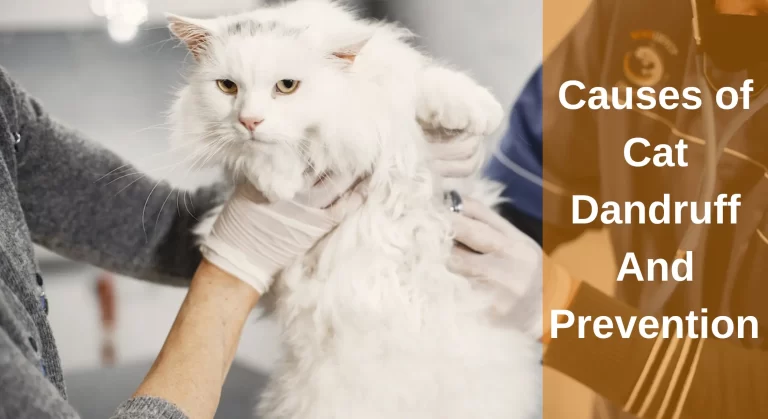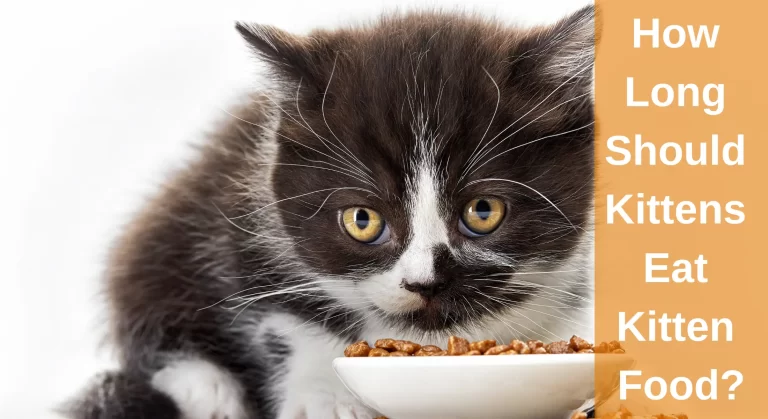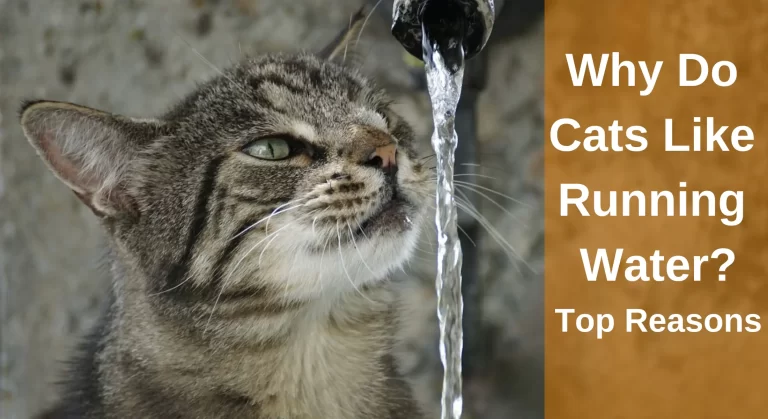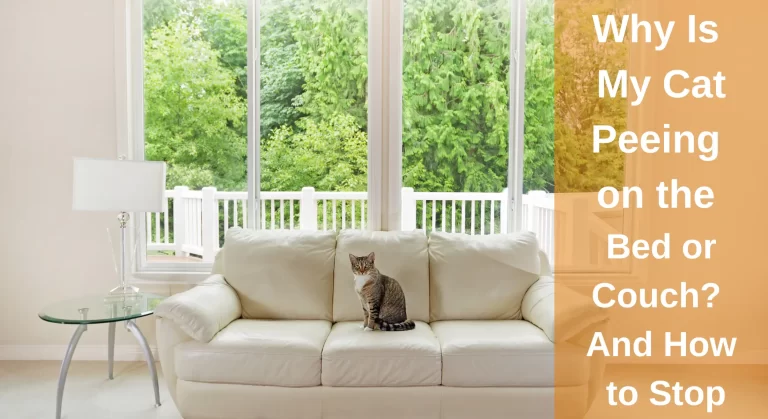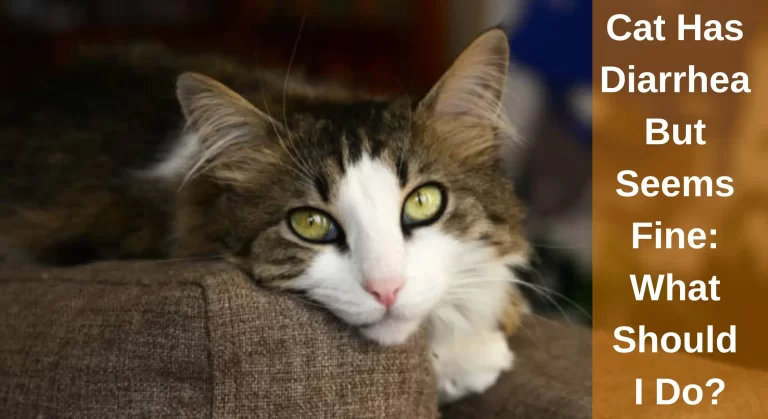My Cat Ate My Garlic Bread: What Should I Do [Answered]?
You probably enjoy garlic bread and pick it as your favorite food for Sunday’s breakfast. Does your feline purr when you eat something tasty? Does the feline pleadingly ask for a piece of your bread? Did our feline accidentally sneak a piece of garlic bread? Do you fear that your cat will become ill from the garlic bread?
Garlic is toxic to cats, and even a small amount can cause illness. felines lack the enzyme necessary to properly digest garlic and the toxin thiosulphate present in it. So if your cat ate garlic bread, it’s important to monitor them for signs of poisoning, such as vomiting, diarrhea, and pale gums. If you notice any of these symptoms, take your cat to the vet immediately.
You could be concerned that giving them garlic bread will make your feline ill. This article is the right spot for you as we’ve included some facts on garlic bread and when it makes your feline ill, what’s the symptoms, how can you prevent garlic poisoning, healthy alternatives, and much more!
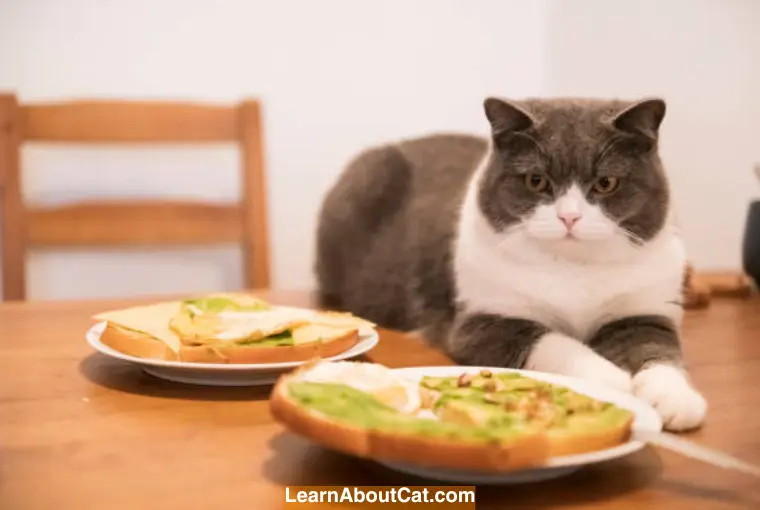
What Is Garlic Bread?
A variety of bread known as garlic bread is made with unsalted butter, olive oil, and garlic spread on top. It might also include additional herb or spice blends. It is then baked or grilled till it’s crisp and golden brown. People all across the world love this snack or side dish. It is often eaten as an appetizer or as a side dish with pasta recipes.
There are times when cats like to eat bread and appear to enjoy bread. They may not be getting enough nutrients from their food, so they consume garlic bread to make up for it. It’s also noteworthy that certain felines seem to enjoy eating garlic bread merely as they enjoy doing so.
My Cat Ate My Garlic Bread
If you catch your feline companion nibbling your garlic bread, take the rest of the food away. Attempt to figure out the quantity they consumed. Intoxication in cats can result from a few and even one clove. If your feline only licks the edge of the bread, it should be fine. But if it bites the garlic bread, get in touch with your veterinarian or a nearby emergency veterinarian clinic.
There certainly isn’t any cause for concern if the garlic bread is handmade and you are confident that you used minimal garlic. If you used the oil and garlic excessively, you might have a worse problem. Call the veterinarian to be cautious if you’re concerned because the garlic bread was purchased or you got it from a supermarket.
Try not to force your cat to vomit. This may also result in you getting attacked. Moreover, due to inducing vomit the bread pieces may stuck in their throat and may cause stomach discomfort or other problems.
Check Out: My Cat Ate Spaghetti Sauce:
Symptoms of Garlic Toxicity in Cats
Garlic bread toxicity in felines may appear as signs as soon as an hour after intake or up to 4 days later. It varies on the cat’s inherent tolerance to poisons, the quantity that the cat consumed, and how strong the garlicky taste was. A lack of hunger, difficulty breathing, diarrhea or vomiting, yellow gums, an increased heart rate, and fainting are among the symptoms.
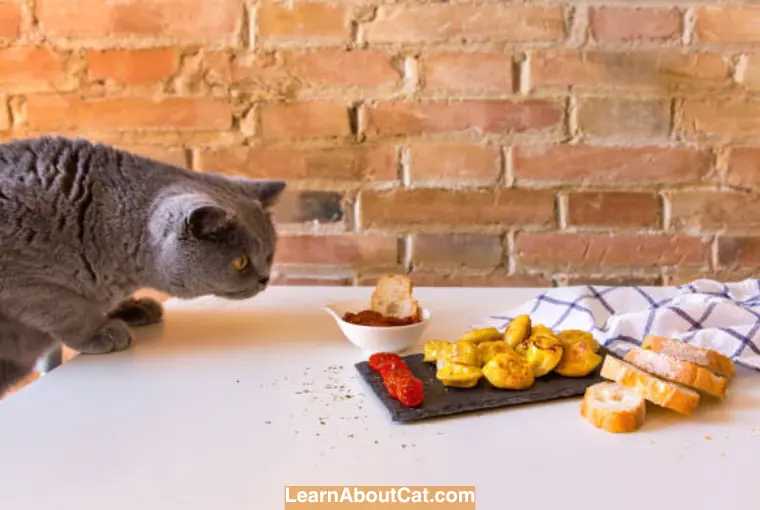
Lack of Interest in Eating
Your feline will lose hunger due to the garlic in it because it will make them feel queasy and make it difficult for them to fall asleep. While your feline is battling any disease, nutrition is crucial, so encourage them with soup or their preferred snacks. Try salmon broth if their tummy is too disturbed to handle solid food.
Difficulty Breathing
Garlic poisoning can manifest in ways that mimic allergic reactions. Your feline’s trachea may be closing if they start having difficulty breathing all of a sudden. If they have an abnormally raspy voice or are panting unnecessarily, you can contact your vet.
Dysentery-Nausea
If an animal consumes toxic items, the body strives to eliminate them as quickly as it can. It may occur through diarrhea or nausea. If your cat typically doesn’t get furballs, this might indicate garlic poisoning.
Look for pieces of bread or garlic in the vomiting. Unbelievably, it’s preferable if you can still see bits so this indicates the cat hasn’t completely eaten it. Possibilities are that your cat will be all right within a few hours or days if they only had a few nibbles and you could only locate a few leftover bits.
Yellow Gums
The gums of your felines should be a pinkish-to-red hue. Yellow gums are a sign of garlic poisoning since it makes cats anemic. This occurs when the feline’s body is unable to produce and sustain RBCs as a result of the garlic. You might not notice this sign for a few days.
If their gums are very peachy pink or white, call the veterinarian right once. Ignoring this sign might result in neurological disorders, blood disorders, poor circulation, and even fatality.
Increasing Heart Rate
You will notice an accelerated heartbeat along with yellow gums and respiratory problems. This is due to the fact that as RBCs are lost from the blood, the body lacks oxygenation. The feline’s body strives to transport very little oxygen left in the arteries, which causes a rise in a heartbeat.
Instead of after you’ve done playing with your feline, monitor your feline’s pulse once they’re relaxed or lying on the floor. Wait till they have cooled down to determine whether they’re experiencing the zoomies. By putting your palm on their left side, directly below their frontal leg, you can examine their heartbeat.
Collapse
Make an emergency appointment with the vet if your feline unexpectedly faints. It makes no difference whether you haven’t experienced any prior signs. When you get there, tell the veterinarian when, how many, and how long you’ve been keeping an eye for during that time.
Also, Check Out: My Cat Ate A Chocolate Chip: Will 1 Chocolate Chip Hurt a Cat
What to Do If Your Cat Overate Garlic?
If you saw that your feline ate excessive amounts of garlic bread. You can take the following precautions:
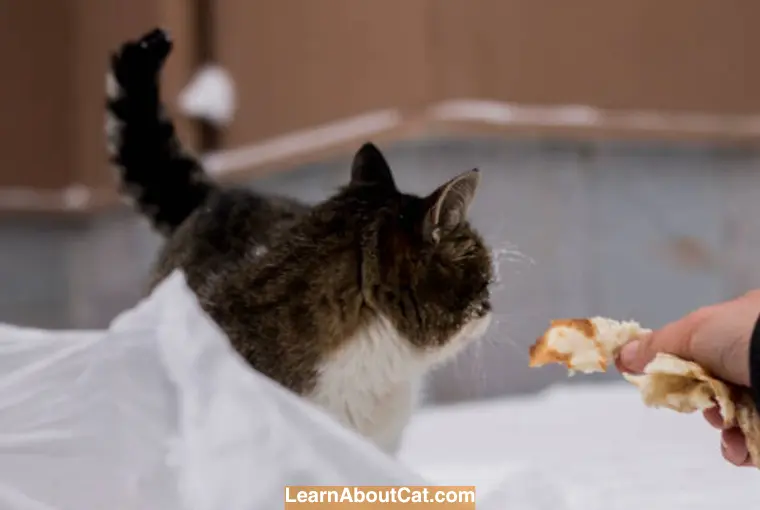
Stop Your Feline
If you’ve discovered that your cat has consumed leftover garlic bread, you should immediately remove the bread from its mouth. Cats often eat things that are not good for them because of their curious nature. As their owner, it is your responsibility to keep them safe. Monitor your cat for any signs of illness, such as vomiting, diarrhea, or lethargy.
Call Your Vet
If your feline begins to exhibit the aforementioned signs, you could become concerned. Get in touch with your veterinarian immediately away to make certain. Your veterinarian will advise you on how to assist your feline to puke with a solution containing hydrogen peroxide. This will assist your cat get rid of the ingested garlic and stop additional damage.
Your feline might need to be brought to the clinic if its illness gets worse. In severe cases, cats typically need a remedy known as “oxygen therapy.” To make sure all poisons have been removed from the stomach, a gastric lavage—in which the felines’ stomach is washed may also be carried out.
Activated charcoal may also need to be administered by the veterinarian. Toxicants cannot reach your cat’s circulation and trigger further harm since activated charcoal absorbs them.
Your feline’s health must be closely monitored by the veterinarian to see if he requires care and support, including IV fluids. Due to the vomiting and diarrhea that felines with garlic overdose frequently have, IV fluids are frequently required to keep them from becoming dehydrated.
Recovery
Even though your feline may already be exhibiting signs of normality, your vet may decide to keep him in the office to make sure they are in a stable condition. To aid in your cat’s recovery, your veterinarian could also suggest at-home treatment. Be sure that there is no garlic in your feline’s usual food.
Find Out: My Cat Ate Chocolate Muffin Wrapper: What Should I Do?
How Much Garlic Is Toxic to Cats?
Even the smallest bit of garlic, such as one piece or 197 mg of garlic powder, can cause poisoning because it is so harmful to cats. The body weight, breed, and history of your cat’s ailments all affect how dangerous the substance is. Garlic poisoning affects some breeds more than others, including Siamese, Burmese, Japanese, and Singapura.
Garlic should be strictly prohibited, despite some rumors to the contrary. Garlic has no preventative benefits for cats.
Also Read: My Cat Ate a Whole Bag of Treats: What Should I Do?
Why is Garlic Toxic to Cats?
Garlic bread can serve as a delectable treat for people, but it can be harmful to cats. Toxic substances for felines can be found in garlic bread including garlic, fats, and excess salts. Let’s figure out how these ingredients are toxic for cats:
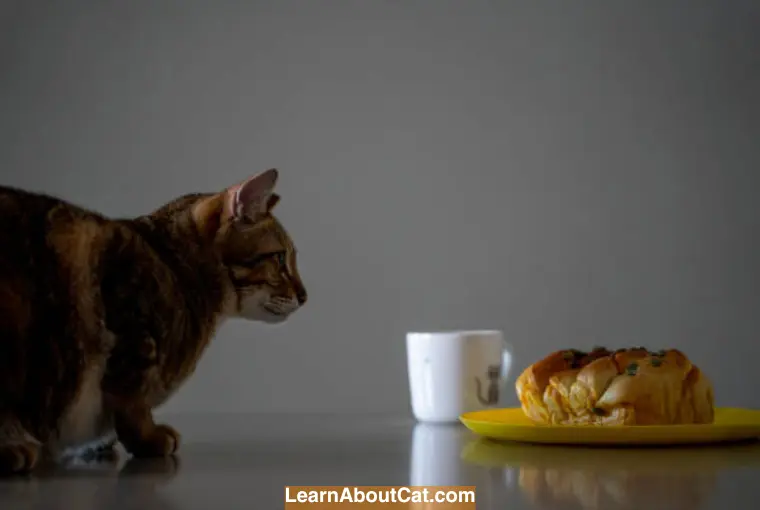
Garlic
The main ingredient of garlic bread is garlic which relates to the Allium family which also includes onions and chives. This toxic substance contains some compounds such as thiol groups and thiosulphates that can induce hemolytic anemia in cats by degrading their red blood cells.
Garlic toxicity can result from ingesting even a tiny portion of garlic clove or a teaspoon of garlic powder. Garlic toxicity can cause respiratory issues, yellow gums, drooling, an irregular heartbeat, and in certain extreme cases, organ dysfunction.
You shouldn’t give your pet anything which includes garlic. She may beg and scream for a piece of garlic bread, but the health of your feline must always come first.
Salt
Although salt is not poisonous to felines, your cat shouldn’t take it in large quantities. Most pet owners overlook the fact that giving their cherished animal human food usually comes with a drawback. Salt won’t take your feline to the emergency veterinary clinic, but she might rush to the litter box as a result.
It helps to keep in mind that some types of garlic bread include a substantial amount of salt which may result in salt toxicity. Salt toxicity may cause excessive thirst and peeing, clumsiness, drowsiness, nausea, and diarrhea.
Fats
Last but not least, we must not overlook the unsalted butter and olive oil that is included in garlic bread. However, a little bit of fat can be good for the condition of your cat’s fur.
Sadly, eating too much fat can cause a variety of health issues. These extremely serious illnesses, such as excess weight, overweight, diabetes, liver, pancreatic, and heart disease, are caused by overfeeding or underfeeding your feline over an extended period.
It’s possible that your cat doesn’t enjoy garlic bread too much. There are too many hazards, too many carbs, as well as excessive garlic.
Healthy Alternative to Garlic Breed
Even if it makes a great treat for people to consume, not all of your favorite foods are necessarily good for cats.
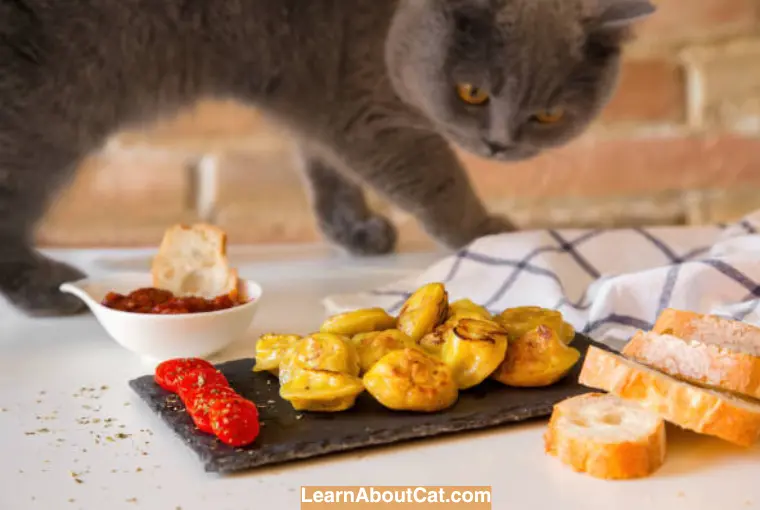
Your cat won’t profit from eating garlic bread in terms of health. Size, calories, and fats are all parts of it. Select the appropriate food from the following menu. All these food items are delicious and wholesome snacks for felines:
- Bananas (best snack to feed in moderation)
- Berries (healthy and flavorful)
- Melon (full of vitamins)
- Carrots (safest snack)
- Pumpkin (high fiber content helps to reduce constipation)
- Oatmeal (contains iron and fiber in abundance)
- Vegetables such as lettuce, broccoli, etc.
How to Prevent Accidental Garlic Poisoning? How to Prevent Garlic Poisoning in Cats?
Prevention is always better than cure, especially when it comes to your cat’s health. Here are some measures you can take to prevent accidental garlic consumption:
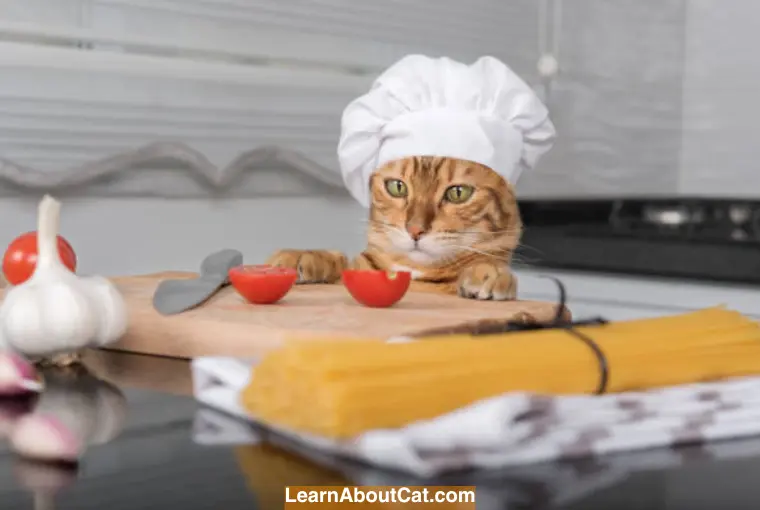
Secure Food Storage
It doesn’t matter if the garlic is in slice or toast form—still, it’s dangerous. If you have a curious cat, you have to hide snacks under dishes, in jars, in cabinets, or on bookshelves. Garlic powders and pieces must be stored in a high seasoning cupboard with a lid closed.
Awareness of Ingredients
Keep the ingredients especially garlic nearby while you preparing food, and only uncover them when necessary.
Avoid feeding your cat table scraps, especially if they contain ingredients that are toxic to cats. Stick to a balanced and nutritious cat food diet recommended by your veterinarian.
Educate Family Members and Guests
Inform your family members and guests about the dangers of garlic for cats. Request their cooperation in not feeding any garlic-containing foods to your cat, including garlic bread.
Keeping Garlic Bread Out of Reach
Collect everything you spill on the floor right away, so that your cat can’t lick it. Place the garlic bread at some high place when you take it out of the oven for cooling and keep an eye on your cat, so he can’t sneak a piece of garlic bread.
Are There Any Benefits to Adding Small Amounts of Garlic to Your Cat’s Diet?
While garlic may have some potential health benefits for humans, it is not recommended to add small amounts of garlic to your cat’s diet. Cats are more sensitive to the toxic compounds found in garlic, such as thiosulfate, which can damage their red blood cells and lead to anemia. The risks of garlic toxicity outweigh any potential benefits. It is best to consult with a veterinarian for appropriate dietary recommendations for your cat’s specific needs.
Frequently Asked Questions
Is garlic bread safe for cats?
No, garlic bread is not safe for cats. Even tiny amounts of garlic are harmful to cats. Garlic, which is used to make garlic bread, can be dangerous for cats to consume in excess. Cats who eat garlic may develop anemia and become ill.
The most hazardous allium veggie is garlic, which is 5 times deadlier than shallots. It has substances called disulfides and poisonous chemicals that can kill your cat’s RBCs.
Anemia, a horrible disorder in which RBCs are destroyed more quickly than they’re generated, is brought on if garlic gets into your cat’s gastrointestinal tract. Hemolytic anemia is caused by thiol groups and thiosulphates getting into circulation. If this severe anemia is not treated right away, it can be fatal.
Can garlic bread kill cats?
Garlic bread can be toxic to cats and, in extreme cases, can potentially lead to fatal consequences. Cats are poisonous to certain substances found in garlic which can destroy their blood cells and lead to anemia. The severity of the toxicity depends on the amount consumed and the individual cat’s sensitivity. However, if your feline consumes it in bulk, he will be in danger.
Can cats eat garlic for fleas?
No, giving felines garlic to get rid of fleas is not advised. Cats are poisonous to certain substances found in garlic, including disulfide and thiol groups which can harm their oxygen-carrying blood cells and result in anemia. Garlic may also disturb a cat’s digestive system.
Can I still feed plain bread to my cat?
Even while simple bread may not be poisonous to felines, it is not advisable to give them big or frequent servings of it. Bread can lead to obesity and gastrointestinal issues for felines and lacks the nutrition they require to nourish themselves with a healthy meal.
How long does it take for symptoms of garlic poisoning to appear in cats?
The onset of garlic toxicity symptoms in cats can vary. In some cases, symptoms may appear within a few hours, while in others, it may take several days.
Wrap Up
Garlic bread may be tempting, but it poses potential dangers to cats. it’s crucial to keep them away from foods like garlic bread. If you suspect that your cat has ingested garlic bread or shows any symptoms of garlic poisoning, contact a veterinarian immediately.
According to the extent of the poisoning, many treatments are available for cats who have consumed garlic bread. Your feline may heal by itself in some circumstances without the need for any therapy. But, if your feline exhibits symptoms of a disease, they can require supportive therapy while being hospitalized.
Remember to take preventative measures to ensure your cat’s well-being, including secure food storage, ingredient awareness, and keeping potentially harmful foods out of reach. By being vigilant and prioritizing your cat’s health, you can help keep them safe from the dangers of garlic.
Related Posts:
Who is Isabella?
My name is Isabella, and I am a dedicated and knowledgeable cat enthusiast. With years of experience caring for cats and a deep love for felines, I made a mission to help other cat lovers navigate the challenges of cat ownership.

